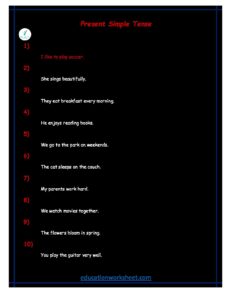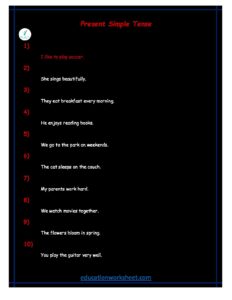how to converting Present Simple Tense positive sentences to negative form
how to converting Present Simple Tense positive sentences to negative form
Basic Structure of Present Simple Tense Before diving into negating Present Simple tense sentences, it’s essential to understand its basic structure. In the affirmative form, a Present Simple tense sentence typically consists of a subject, a base verb (or a verb with an -s ending for the third person singular), and any necessary additional information or adverbs.
For example, in the sentence “She sings beautifully,” the subject is “She,” the verb is “sings,” and “beautifully” is an adverb.
Converting to the Negative Form

To convert a Present Simple tense positive sentence into a negative one, we generally follow these rules:
- Add “do not” or “does not” (contracted as “don’t” or “doesn’t” in spoken English) before the base verb.
- Positive: She sings.
- Negative: She does not sing. (or She doesn’t sing.)
- Positive: They eat pizza.
- Negative: They do not eat pizza. (or They don’t eat pizza.)
- Modify the verb to its base form (remove any -s or -es endings) for the negative form in the third person singular (he, she, it).
- Positive: He plays guitar.
- Negative: He does not play guitar. (or He doesn’t play guitar.)
- In negative sentences, you can also add a specific time adverb or phrase to indicate when the action does not happen.
- Positive: They swim in the pool.
- Negative with time adverb: They do not swim in the pool during the winter. (or They don’t swim in the pool during the winter.)
- Use the appropriate subject pronoun and auxiliary verb (“do” or “does”) to match the subject of the sentence.
- Positive: We visit the museum.
- Negative: We do not visit the museum. (or We don’t visit the museum.)
- Positive: She cooks dinner.
- Negative: She does not cook dinner. (or She doesn’t cook dinner.)
- Don’t forget to maintain the tense of the main verb in the base form.
- Positive: They study English.
- Negative: They do not study English. (or They don’t study English.)
how to converting Present Simple Tense positive sentences to negative form

Now, let’s explore some more examples of converting positive Present Simple tense sentences to their negative counterparts:
Positive: I watch TV every evening. Negative: I do not watch TV every evening. (or I don’t watch TV every evening.)
Positive: He reads books on Sundays. Negative: He does not read books on Sundays. (or He doesn’t read books on Sundays.)
Positive: The train arrives at 9 AM. Negative: The train does not arrive at 9 AM. (or The train doesn’t arrive at 9 AM.)
Positive: Mary cleans her room twice a week. Negative: Mary does not clean her room twice a week. (or Mary doesn’t clean her room twice a week.)
Positive: The sun rises in the east. Negative: The sun does not rise in the west. (or The sun doesn’t rise in the west.)
Positive: They play basketball after school. Negative: They do not play basketball after school. (or They don’t play basketball after school.)
Positive: Sarah speaks French fluently. Negative: Sarah does not speak French fluently. (or Sarah doesn’t speak French fluently.)
In summary, converting Present Simple tense positive sentences to negative form involves adding the appropriate auxiliary verb (“do” or “does”) in the negative form, adjusting the main verb to its base form in the third person singular, and potentially including time adverbs or phrases to provide context. By following these rules and practicing with various sentences, you can effectively communicate negations in the Present Simple tense, allowing for a more comprehensive expression of facts, habits, and routines in English.

